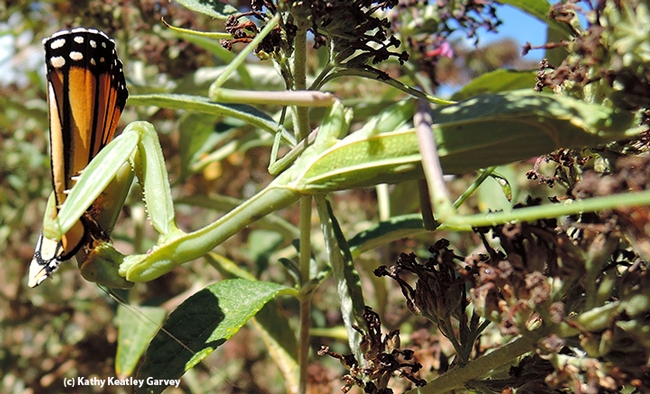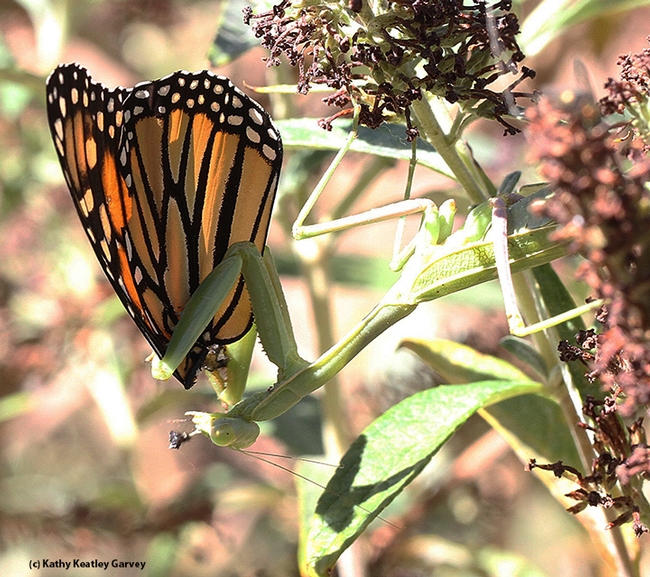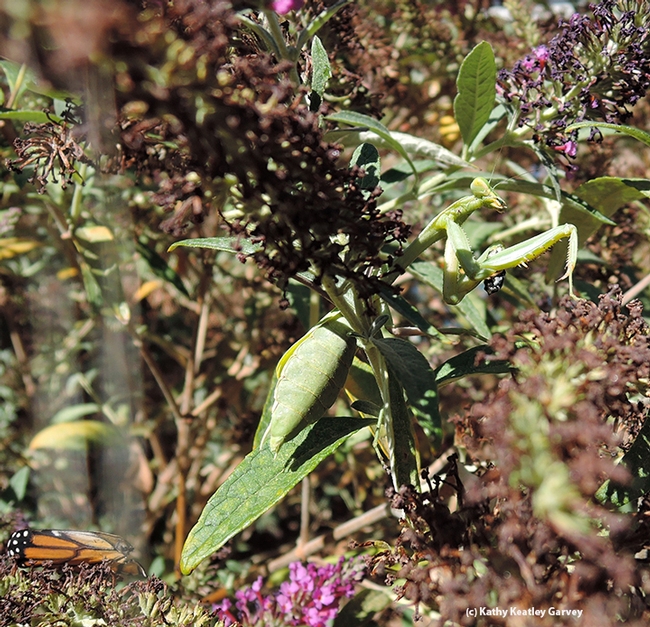- Author: Kathy Keatley Garvey
The honey bee struggled, but couldn't free herself from a broadleaf milkweed blossom in our pollinator garden. Had a predator nailed her? Or was the bee dying of natural causes? What was happening?
Two hours later we returned. The bee, now in a frenzy, was still stuck. We offered her sips of honey from a coated toothpick.
"Ah, with that flight fuel, she'll take off," we thought. She did not. Closer examination revealed her foot (tarsi) stuck in a mass of sticky pollen.
We separated the bee from her floral trap by lifting her from the gluelike pollinia with the toothpick. Off went the pollinia and off went the bee.
“If you hang around that milkweed, you might be able to get a photo of a bee carrying pollinia on its foot,” Extension apiculturist (emeritus) Eric Mussen of the UC Davis Department of Entomology and Nematology told us.
So, last weekend, armed with a camera and the memory of the frenzied bee, we waited. And waited. And waited. And got it. A bee flying off chained with golden pollinia.
Unlike most flowering plants, only milkweed and orchids produce pollinia, which is a sticky packet of golden pollen grains originating from a single anther. The wishbone-shaped pollinia are in a nectar trough where insects--or parts of them--often get trapped. This is a devious way for milkweed and orchids to force insects to “take me with you” and “help us reproduce.” If you're a small insect and/or not strong enough to loosen the grip, you'll be lodged in that sticky mass and die. It's sort of like jumping into quicksand and you can't get out. Some insects manage to escape but their parts remain. That's probably one reason why you see "amputated" bumble bees, carpenter bees, honey bees and butterflies, no thanks to the Sophisticated Reproductive Habits of the Milkweed (and Orchids).
The milkweed plant is not only the larval host--and only larval host--of the monarch butterflies, but it's a nectar source for butterflies and for many other insects--including honey bees, leafcutter bees, bumble bees, carpenter bees, syrphid flies and ants.
In fact, if you look closely at a broadleaf milkweed blossom (Asclepias speciosa), you'll see dozens of tiny pink flowers forming the umbel or umbrella-shaped structure. The corona, located on top of the petals, holds a circle of five hoods and five horns. Hoods and horns pointing the way. The hoods that hold that oh-so-sweet nectar beckon insects like a kid to a candy store. Each blossom has five vertical slits which house the reproductive organs.
So, what was happening? Ms. Honey Bee, seeking nectar for her colony, hit a sweet jackpot and repositioned herself to gather it. Then her foot slipped into one of the five sticky slits and she couldn't remove her leg.
Ms. Honey Bee survived, thanks to a human being with a toothpick. Others are not so lucky.
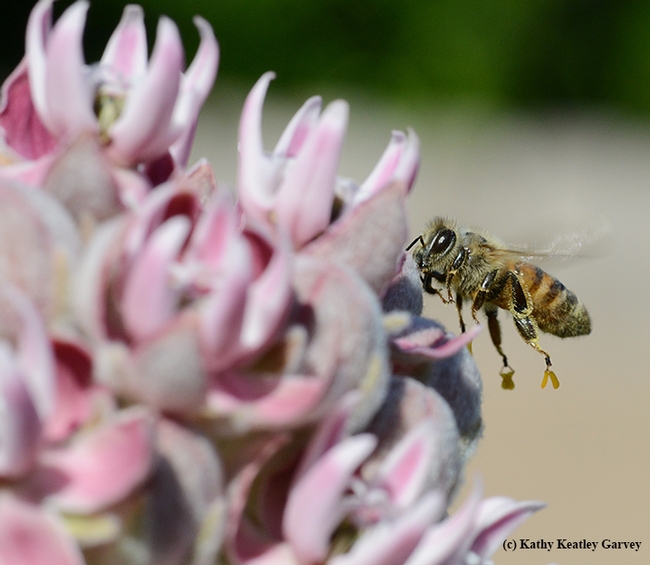

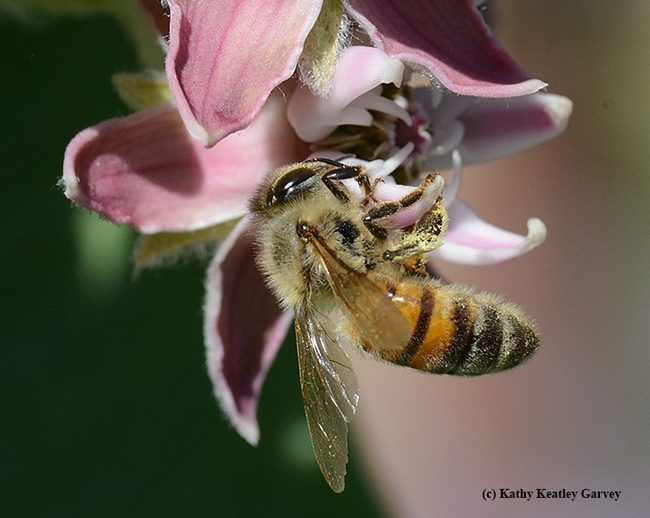
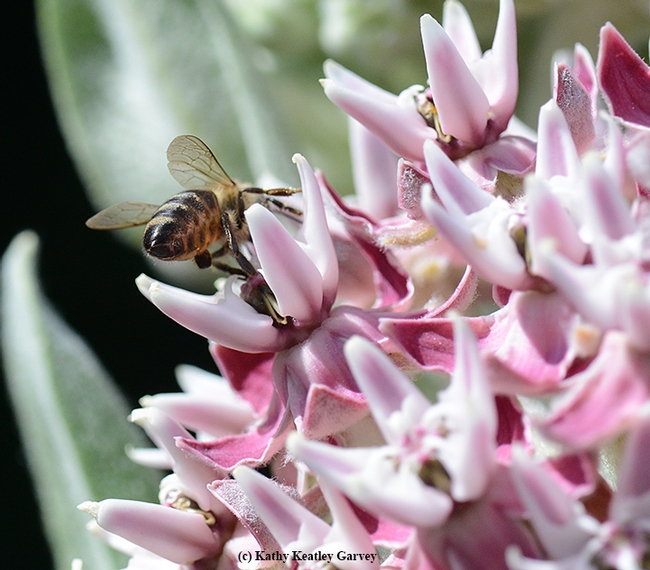

- Author: Kathy Keatley Garvey

The more we know about monarch butterflies, the better we can understand them and help conserve them.
Newly published research on California's overwintering monarch butterflies (Danaus plexippus) confirmed many previous migratory studies, but found some unexpected and surprising patterns of movement, said lead researcher Louie Yang, a community ecologist with the UC Davis Department of Entomology and Nematology.
The study, “Intra-Population Variation in the Natal Origins and Wing Morphology of Overwintering Western Monarch Butterflies (Danaus plexippus)," published in the early online version of the journal Ecography, examined the natal origins, or “birthplaces,” of butterflies at four California overwintering sites.
It will be incorporated into an online issue, perhaps within six months, but it has not yet been assigned to an issue, said journal managing editor Maria Persson.
Natal origins of butterflies collected from the two northern sites--Lighthouse Field State Beach and Moran Lake, both in Santa Cruz County--varied significantly from those collected at the two southern overwintering sites--Pismo State Beach, San Luis Obispo County; and the Coronado Butterfly Preserve, Santa Barbara County, they said.
“We hope that this paper improves our understanding of where monarch butterflies grow up in western North America,” said Yang, an associate professor. “This study uses a naturally occurring continental-scale pattern of hydrogen isotopes in precipitation in order to estimate the natal origins of overwintering butterflies. Building a clearer understanding of where they come from could help us better understand many aspects of their ecology.”
The research is the work of Yang; Dmitry Ostrovsky of the University of Colorado, Denver; and Matthew Rogers and Jeffery Welker of the University of Alaska.
The research team set out to answer two key questions: “How do broad geographic areas of potential natal habitat contribute to the overwintering population of western monarch butterflies in California?” and “How does the individual variation in the wing morphology of overwintering western monarch butterflies correlate with estimated migratory distance from their natal origins?”
They first compared the wings of 114 monarch butterflies collected from the four overwintering sites with a continental-scale monarch butterfly wing isoscape derived from the U.S. Network for Isotypes in Precipitation (USNIP) database. They used spatial analyses of stable isotype ratios and correlations with wing morphology. Then they examined the correlations of monarch butterfly forewing size and shape.
Of the 114 butterflies sampled, they found that 30 percent developed in the southern coastal range; 12 percent in the northern coast and inland range; 16 percent in the central range, and 40 percent developed in the northern inland range.
“Interestingly, the two most northern overwintering sites in the study showed the largest contributions from the southern coastal range (Lighthouse Field, 45 percent; Moran Lake, 37 percent; Pismo Beach, 22 percent; and Coronado Preserve, 24 percent) while the two most southern overwintering sites showed the largest contributions from the northern inland range (Lighthouse Field, 30 percent; Moran Lake, 35 percent; Pismo Beach, 53 percent; and Coronado Reserve, 39 percent),” they wrote.
The researchers randomly collected the monarchs Dec. 4-6, 2009 from aggregations in trees. The collecting resulted in: 19 males and 9 females from Coronado; 22 males and 8 females from Pismo State Beach; 20 males and 10 females from Moran Lake; and 18 males and 8 females from the Lighthouse Field State Beach.
In addition, the male monarch butterflies showed mean total masses that were 5.8 percent larger than those of the females.
The monarch butterfly of North America overwinters along the California coast and in the central mountains of Mexico. Previous studies have indicated that the western monarchs or those from natal habitats west of the Rocky Mountains, overwinter along the California coast. Those that develop east of the Rockies overwinter in central Mexico.
The project was funded in part by a National Science Foundation (NSF) Early Career Development Program grant awarded to Louie Yang, and a NSF Major Research Instrumentation Program grant awarded to Jeffrey Welker.
(Note: For more information on monarchs, read the Xerces Society's website. Xerces also encourages us all to plant milkweed. See Project Milkweed.)

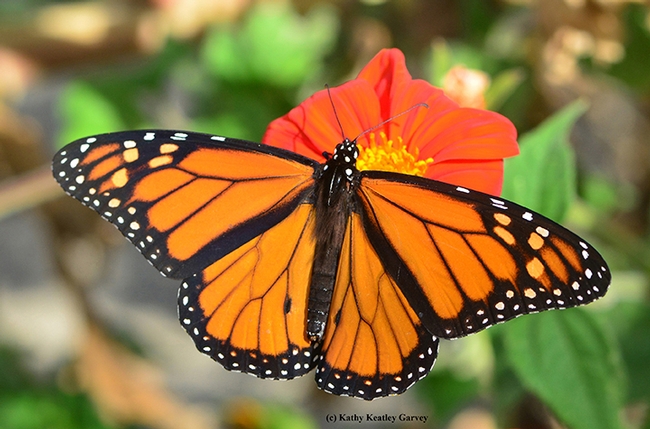

- Author: Kathy Keatley Garvey

You're yearning to see monarch eggs, caterpillars and chrysalids on milkweed. Ditto for the pipevine swallowtails on their host plant, Dutchman's pipe.
You also want some butterfly bushes and other nectar plants.
And you're thinking of replacing your drought-stricken lawn with drought-tolerant plants.
You're in luck!
The UC Davis Arboretum Plant Sale is Saturday, Oct. 24 from 9 a.m. to 1 p.m. at the Teaching Nursery on Garrod Drive. (See directions)
"We're going to have a lot plants -- over 16,000 – including lots of Arboretum All-Stars in honor of their 10-year anniversary," spokesperson Katie Hetrick told us today.
The All-Stars are 100 specially selected plants "that have provided California with a foundation for creating attractive, easy-care landscapes that save water." A large selection of Arboretum All-Stars, California natives, and other regionally appropriate plants will be available.
The public sale offers benefits for Arboretum members, who can save 10 percent. Non-members can join at the door. For additional information, see benefits of memberships.
What's available at the plant sale? Is there a list? Yes, and folks are checking it twice! You can access it on the website or download the PDF.
While you're on the campus, you can explore the 100-acre UC Davis Arboretum, a horticultural and cecreational treasure filled with scientific collections, demonstration gardens, educational information and art work. You can walk or bike the trails. Bring your camera.
If you're lucky, a monarch will flutter by.



- Author: Kathy Keatley Garvey
The circle of life...
Monarch caterpillars feast on milkweed, their host plant. Oleander aphids feast on the juices of milkweed plants. Lady beetles, better known as ladybugs (but they're beetles, not bugs) feast on the aphids.
The milkweed is the only plant that the monarch caterpillars eat. Oleander aphids, as their name implies, are also commonly found on oleander. And lady beetles not only eat aphids, but soft-bodied insects such as scales, white files, mites, and yes, monarch butterfly eggs.
The UC Statewide Integrated Pest Management Program (UC IPM) says California has some 200 species of lady beetles and that "most are predators both as adults and larvae."
If you've ever watched a lady beetle go through the aphid cafeteria and select the menu (big, little, small, winged, wingless, fast, slow, near, far), it's quite a sight.
One lady beetle can eat 50 aphids a day, scientists say. During its lifetime, that can mean 5000 aphids.
As for the oleander aphids (Aphis nerii), they derive their name from Nerium, the genus name for oleander. Both are the oleander and oleander aphid are reportedly native to the Mediterranean region.
If you have milkweed, you probably have aphids. Oleander aphids. And you probably have lady beetles eating those aphids. And the monarch eggs...
The circle of life..
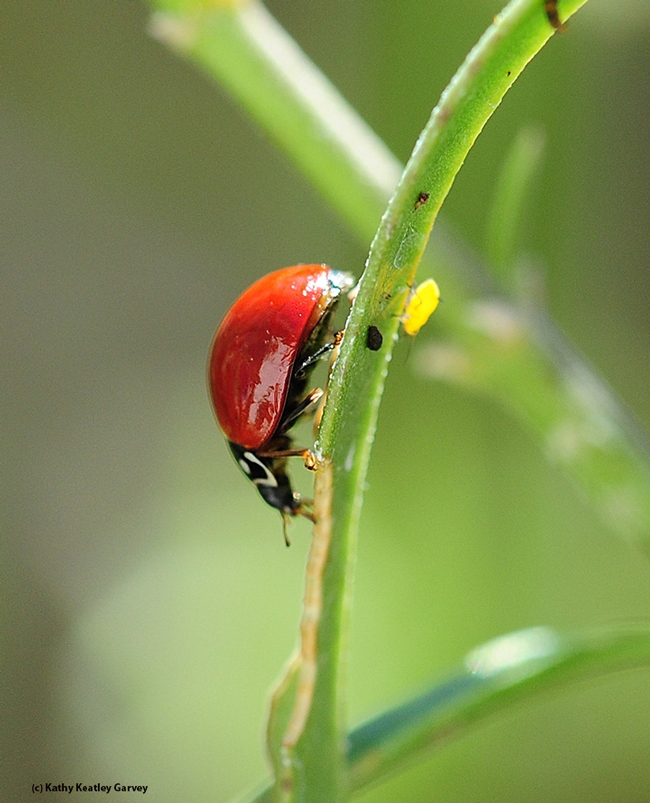

- Author: Kathy Keatley Garvey
It's a sin to kill a mockingbird, wrote Pulitzer Prize-winning author Harper Lee in her classic novel, "To Kill a Mockingbird."
"Mockingbirds don't do one thing except make music for us to enjoy," one of her characters, Miss Maudie, wisely observed. "They don't eat up people's gardens, don't nest in corn cribs, they don't do one thing but sing their hearts out for us. That's why it's a sin to kill a mockingbird."
Harper Lee's work came to mind yesterday when we saw a praying mantis devouring a monarch butterfly on our butterfly bush, located next to several milkweed plants. We watched the clipped monarch wings flutter down and land among the leaves.
It was a female monarch. She may have stopped to sip some nectar during her egg-laying mission. The hungry predator ambushed her.
The shock of seeing a delicate monarch gripped between spiked forelegs stuns you, especially when you've just reared two monarchs and have two more to go.
"Umm, do you mind?" we wanted to ask the mantis. "Please eat the cabbage white butterflies, stink bugs and aphids, not the monarchs."
Praying mantids are considered beneficial insects, but all we've seen them eat are honey bees, sunflower bees, butterflies and an occasional Gulf Fritillary caterpillar. However, they do eat ants, wasps, flies, and moths, as well. The larger praying mantids prey on hummingbirds.
The Xerces Society for Invertebrate Conservation summed up the monarch decline well on its website: "Monarch butterflies (Danaus plexippus) of North America are renowned for their long-distance seasonal migration and spectacular winter gatherings in Mexico and California. The monarch butterfly population has recently declined to dangerously low levels. In the 1990s, estimates of up to one billion monarchs made the epic flight each fall from the northern plains of the U.S. and Canada to sites in the oyamel fir forests north of Mexico City, and more than one million monarchs overwintered in forested groves on the California Coast. Now, researchers and citizen scientists estimate that only about 56.5 million monarchs remain, representing a decline of more than 80% from the 21 year average across North America."
Okay, praying mantis. We know. It was only one. You have to eat, too. You needed the protein to lay your ootheca. But have you ever considered how tasty and prevalent cabbage white butterflies are?
